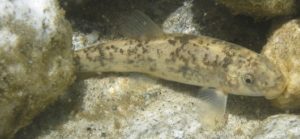Catostomus santaanae
- Threatened – Endangered Species Act (2000)
- Endangered – IUCN Red List (2014)

Santa Ana sucker. Photo by Manna Warburton.
Description
The Santa Ana sucker is a small fish averaging about three inches in length. The largest length recorded was about 9.8 inches. They are grey to dark grey, and have dark blotches on their sides; their underside is typically lighter than their sides. Most notably it is characterized by the downward orientation of its mouthparts, a characteristic of many other suckerfish.
Habitat and Distribution
The Santa Ana Sucker is endemic to southern California and is native to only the Los Angeles, San Gabriel, Santa Ana, and Santa Clara River systems. Within the Los Padres National Forest, the Santa Ana Sucker is found within Piru Creek and Sespe Creek, both of which are tributaries to the Santa Clara River. It is one of only a few native fish species left in southern California.
The Santa Ana Sucker is found within clear, small to medium size streams with gravel, rubble, and rock substrates, as well as vegetation on the side. Santa Ana suckers have been found in high abundance only in relatively pristine environmental conditions. They have been found in rivers that are both swift moving, and relatively calm. The suckers survive rough, fast-moving water by seeking refuge in the backward flowing eddies of the river during swift flows.
Life Cycle and Behaviors
Santa Ana Suckers spawn in the spring and summer months from late May to June. The species has a high fecundity, meaning it is capable of producing a large offspring. The females will release as many as 16,000 eggs through multiple spawning acts, and males will fertilize the eggs immediately after the female releases the eggs. Once fertilized, the eggs stick to the stream substrate. Approximately 36 hours later, the larvae will hatch. Most fish only live one to two years, with some living up to four years. The fish is a bottom dweller, and feeds primarily on algae, diatoms, and detritus.
Threats and Conservation
The species was listed as threatened in 2000, and populations are declining largely as a result of hydrological modification, fragmentation of habitat due to permanent barriers (dams), channelization, and degradation of water quality. It is a fish native to one of the country’s largest population centers, and has thus been associated with dramatic decline since the 1970’s.
The species was listed as threatened in 2000 and in 2010, the US Fish and Wildlife Service (FWS) expanded critical habitat for the sucker. It is a species that has caused great controversy, as the Santa Ana suckers critical habitat is also an important water supply source for Los Angeles County. In 2015, dozens of inland water agencies have petitioned to the U.S Supreme Court to reevaluate the decision by the FWS to expand critical habitat for the Santa Ana sucker. The petition is based on the grounds that designation of critical habitat restricts important groundwater extraction in areas that are important for LA County’s water supply. Sadly, without the additional designation of critical habitat, the species is guaranteed to be on the fast track for decline.






